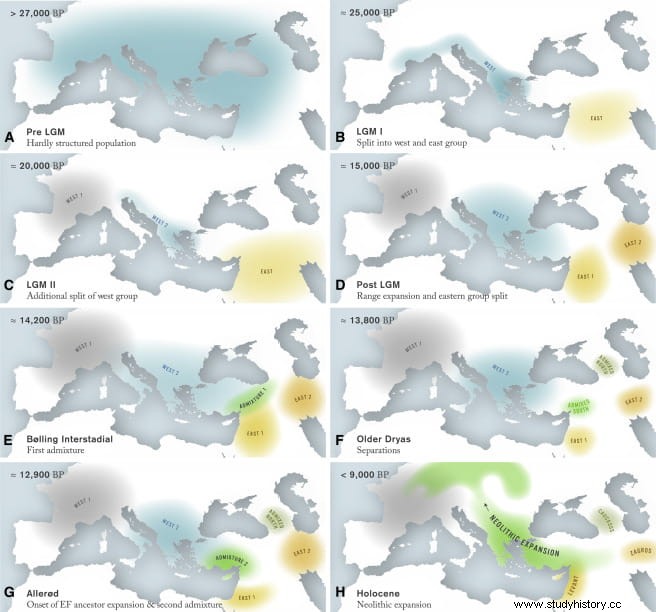The genetic origins of the first Neolithic farmers seemed for a long time to be located in the Near East. A new study published in the journal Cell shows that early farmers actually represented a mix of Ice Age hunter-gatherer groups, stretching from the Near East to southeastern Europe.
Researchers from the University of Bern and the Swiss Institute for Bioinformatics SIB, as well as the Johannes Gutenberg University of Mainz and the University of Freiburg participated in the study. The method they developed could help reveal other patterns of human evolution with unmatched resolution.
The first signs of agriculture and a sedentary lifestyle are found in the so-called Fertile Crescent , a region in the Middle East where people began to settle and domesticate animals and plants around 11,000 years ago. The question of the origin of agriculture and sedentarism has occupied researchers for more than 100 years:did agriculture spread from the Middle East by cultural diffusion or by migration?
Genetic analyzes of prehistoric skeletons have so far supported the idea that early European farmers descended from Anatolian hunter-gatherer populations. Although that may be so, this new study demonstrates that Neolithic genetic origins cannot be clearly attributed to a single region. At the end of the Ice Age, unexpected and complex population dynamics occurred, giving rise to the ancestral genetic makeup of the populations that invented agriculture and sedentary lifestyles, i.e. the first Neolithic farmers.

The first farmers arose from a mixing process that began 14,000 years ago
Previous analyzes had suggested that the early Neolithic people were genetically different from other human groups of the time. Little was known of its origins. Nina Marchi, one of the first authors of the study, from the Institute of Ecology and Evolution at the University of Bern and the SIB, says:Now we discover that the first farmers in Anatolia and Europe arose from a mixed population between hunters- collectors from Europe and the Middle East .
According to the authors, the mixing process began about 14,000 years ago, followed by a period of extreme genetic differentiation that lasted several thousand years.
A novel approach to modeling population history from prehistoric skeletons
This research was made possible by a combination of two techniques:the production of high-quality ancient genomes from prehistoric skeletons, coupled with demographic modeling of the resulting data. The research team coined the term demomegenomic modelling for this purpose.
It is necessary to have genomic data of the best possible quality so that the latest statistical genomic methods can reconstruct with high resolution the subtle demographic processes of the last 30 thousand years , says Laurent Excoffier, one of the lead authors of the study. Laurent Excoffier is a professor at the Institute for Ecology and Evolution at the University of Bern and group leader of the SIB. He initiated the project together with Joachim Burger from the Johannes Gutenberg University in Mainz and Daniel Wegmann from the University of Freiburg. Nina Marchi adds:It is not enough to compare the similarity of different ancient genomes to understand how they evolved. We had to reconstruct the true histories of the populations studied as accurately as possible. This is only possible with complex population genetic statistics .
Interdisciplinarity, the key to solving these ancient puzzles
Joachim Burger, from the University of Mainz and second lead author, highlights the need for interdisciplinarity:It took about ten years to collect and analyze the skeletons suitable for this study. This was only possible thanks to the collaboration of numerous archaeologists and anthropologists, who helped us historically anchor our models .
The historical contextualization was coordinated by Maxime Brami, who works with Burger at the Johannes Gutenberg University. The young prehistorian was surprised by some of the study's conclusions:Europe's first farmers seem to have descended from hunter-gatherer populations that lived from the Middle East to the Balkans. This was not archaeologically predictable .
Towards a general model of human population evolution
Genetic data from fossils (skeletons) are very deteriorated and must be conveniently processed using bioinformatics, as explained by Daniel Wegmann, from the University of Freiburg and group leader at SIB:The high-resolution reconstruction of the The prehistory of Europeans has only been possible thanks to the methods we have developed specifically to analyze ancient fossil genomes .
Joachim Burger adds:With these approaches, we have not only elucidated the origins of the world's earliest Neolithic populations, but have established a general model of the evolution of human populations in Southwest Asia and Europe .
Of course, there are still gaps in space and time, and this does not imply the end of studies on the evolution of humans in this area , concludes Laurent Excoffier. Thus, the team's research plan is already set; they want to supplement their demographic model with genomes from the later Neolithic and Bronze Ages to provide an increasingly detailed picture of human evolution.
